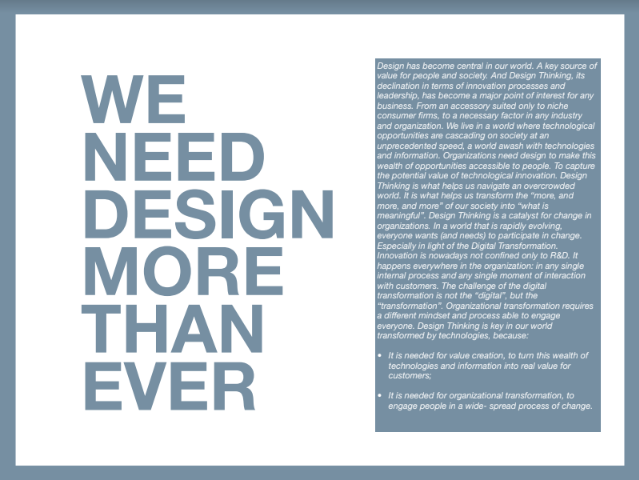Design has become central in our world. A key source of value for people and society. And Design Thinking, its declination in terms of innovation processes and leadership, has become a major point of interest for any business. From an accessory suited only to niche consumer firms, to a necessary factor in any industry and organization. We live in a world where technological opportunities are cascading on society at an unprecedented speed, a world awash with technologies and information. Organizations need design to make this wealth of opportunities accessible to people. To capture the potential value of technological innovation. Design Thinking is what helps us navigate an overcrowded world. It is what helps us transform the “more, and more, and more” of our society into “what is meaningful”. Design Thinking is a catalyst for change in organizations. In a world that is rapidly evolving, everyone wants (and needs) to participate in change. Especially in light of the Digital Transformation. Innovation is nowadays not confined only to R&D. It happens everywhere in the organization: in any single internal process and any single moment of interaction with customers. The challenge of the digital transformation is not the “digital”, but the “transformation”. Organizational transformation requires a different mindset and process able to engage everyone. Design Thinking is key in our world transformed by technologies, because:
- It is needed for value creation, to turn this wealth of technologies and information into real value for customers;
- It is needed for organizational transformation, to engage people in a wide- spread process of change.
Design Thinking creates products by starting from what is meaningful for customers. It creates organizational transformation by starting from what is meaningful for people in your organization: by engaging them in creating innovation instead of adopting it, in collaborating, in nurturing their creative confidence, in bringing their work closer to the purpose of their life. The assumption here is that if people find value in something, then business will follow naturally. Design Thinking, whatever nuance you consider, always has this perspective: to do business by starting from what is meaningful to people. It is a people-first approach put into practice. To use an analogy, Design Thinking applies a basic fundamental rule of life to business: you do not find happiness by searching for it. Happiness is a consequence of a meaningful life. The same is true for profit. You do not create profit by searching for it. Profit is a consequence of making meaningful things for people. Design Thinking is rooted in a fundamental understanding: if something is meaningful for the people who receive it, and for the people who create it, how can business value not easily ensue?



